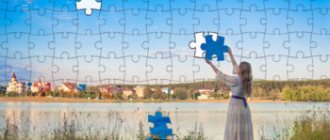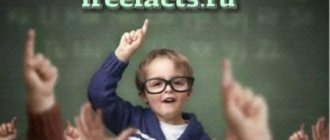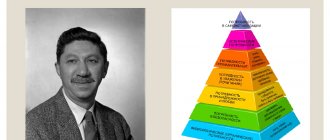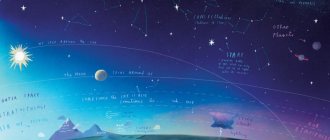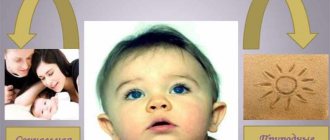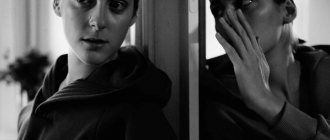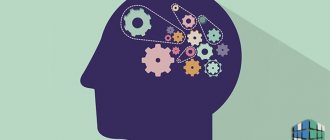Subtleties of interpretation
However, the production of a simple stool is not called a creative process. And the above definition has nothing to do with creating a beautiful stool. This is giving something necessary in everyday life a modern design in order to sell it more profitably. Most likely, the process of creation is a type of spiritual activity that brings satisfaction and spiritual joy to the creator. And even the pangs of creativity, the torment that results in the birth of a beautiful thing, fit organically into the creative process.
Content
- 1 Types of creativity
- 2 Creativity as an ability
- 3 Creativity as a process (creative thinking) 3.1 Stages of creative thinking 3.1.1 From the history of the issue
- 3.1.2 A. Poincaré 3.1.2.1 Stages
- 3.1.3.1 Theory
- 4.1 The nature of the connection between creativity and personality
The presence of the soul is mandatory
If the author puts his soul into his creation, this can be an indicator of creativity. This is, of course, creativity, which will never be treated as soulless mechanical work, even with high-quality performance. There is one more word that is very suitable for the term under study - improvement. Not in the sense of “living conditions,” although the creative process is quite appropriate here, but in relation to the whole world around us. The desire to make human life more beautiful, safer, more worthy is, of course, a process of creation, it is an improvement of the surrounding reality.
Notes[ | ]
- General psychology: Textbook. for pedagogical students in-tov /A. V. Petrovsky, A. V. Brushlinsky, V. P. Zinchenko and others: Ed. A. V. Petrovsky. −3rd ed., revised. and additional - M.: Education, 1986. - 464 p., p. 348.
- Tepikin V.V.
The creative factor of the intelligentsia and intellectuals // Crystallization of the intelligentsia. - Ivanovo, Ivanovo University Publishing House, 2011. - P. 107-127. - Rubinstein S. L. Fundamentals of general psychology. 1946. P. 575.
- Hadamard J. Study of the psychology of the invention process in the field of mathematics. M., 1970. C. 146-147.
- Poincaré A. Mathematical creativity // Hadamard J. Study of the psychology of the invention process in the field of mathematics. M., 1970. Appendix III.
- Hadamard J. Study of the psychology of the invention process in the field of mathematics. M., 1970. P. 19.
- Dr. Kary Banks Mullis, n.d.: https://www.karymullis.com/biography.shtml
- K. Mullis, “Polymerase Chain Reaction,” Dr. Kary Banks Mullis, https://www.karymullis.com/pcr.shtml
- ↑ 12
Pillay, Srini. Jew's harp, dab, dab and try. Unlock the power of a relaxed brain / Srini Pillay; lane from English E. Petrova; [scient. ed. K. Betz]. - M.: Mann, Ivanov and Ferber, 2021. ISBN 978-5-00100-996-2 - K. Mullis, Dancing Naked in the Mindfield (New York: Vintage Books, 1998). P. 3–4.
- Poincaré A. Mathematical creativity // Hadamard J. Study of the psychology of the invention process in the field of mathematics. M., 1970. App. III. pp. 142-143; see also: Hadamard J. Study of the psychology of the process of invention in the field of mathematics. M., 1970. P. 31-33 (Chapter III).
- Artistic creativity as a special type of economy of thought // Questions of theory and psychology of creativity. T. 1. Kharkov, 1907; see also: Ponomarev Ya. A. Psychology of creativity. M., 1976. P. 145.
- Green, 2021, Instinct and Creativity.
- Wallas G. The Art of Thought. NY, 1926; See also: Solso R. Cognitive psychology. 1996.
- Engelmeyer P.K. Theory of creativity. St. Petersburg, 1910; see also: Ponomarev Ya. A. Psychology of creativity. M., 1976. P. 146.
- Yakobson P. M. The process of creative work of an inventor. M.-L., 1934; see also: Ponomarev Ya. A. Psychology of creativity. M., 1976. P. 147.
- Altshuller G. S., Shapiro R. B.
On the psychology of inventive creativity
(undefined)
.
“Questions in Psychology” (No. 6, 1956. - pp. 37-49)
. Website of the Official Foundation of G. S. Altshuller (1956). - Lindzey G, Hall C. & Thompson RF, Psychology, New York, Worth Publishers, 1975
- Reader on general psychology. Psychology of thinking. Ed. Yu. B. Gippenreiter, V. V. Petukhova. M., Publishing house Mosk. Univ., 1981. 400 p. pp. 150-151
- Brief psychological dictionary / Comp. L. A. Karpenko; Under general ed. A. V. Petrovsky, M. G. Yaroshevsky. M.: Politizdat, 1985. P. 165.
- Rubinstein S. L. Fundamentals of general psychology. St. Petersburg: Peter, 2005. P. 551.
- Ananyev B.G. Man as an object of knowledge. St. Petersburg: Peter, 2001.
- Ananyev B. G. Psychology and problems of human knowledge. Moscow-Voronezh. 1996.
- Berdyaev N. A. Experience of eschatological metaphysics // Creativity and objectification / comp. A. G. Shimansky, Yu. O. Shimanskaya. - Mn.: Ekonopress, 2000. P. 20.
- Druzhinin V. N. Psychology of general abilities. St. Petersburg: Peter, 2002. P. 166.
- Jung K. G. Psychological types / Transl. with him. Sophia Lorne/Ed. Zelensky V.V. -St. Petersburg: Yuventa, M.: Publishing House, 1995. −718 p.
- Neumann E. Art and time. In the book: Jung K. G., Neumann E. Psychoanalysis and art. Per. from English -M.: REFL-book, K.: Wakler, 1996. −304 p. pp.153-193.
- Neumann E. Creative person and transformation. In the book: Jung K. G., Neumann E. Psychoanalysis and art. Per. from English -M.: REFL-book, K.: Wakler, 1996. −304 p. Pages 206-249.
- Winnicott D. Game and reality. M.: Institute of General Humanitarian Research, 2002. P. 99.
- May R. The Courage to Create: An Essay on the Psychology of Creativity. Lviv: Initiative; M.: Institute of General Humanitarian Research, 2001. P. 43.
- Berdyaev N. A. The meaning of creativity // Philosophy of creativity, culture and art. M.: Art, 1994. P. 40.
- Vatansever D., Manktelow AE, Sahakian BJ, Menon DK, Stamatakis EA
Cognitive Flexibility: A Default Network and Basal Ganglia Connectivity Perspective. (English) // Brain Connectivity. — 2021. — April (vol. 6, no. 3). - P. 201-207. - doi:10.1089/brain.2015.0388. — PMID 26652748. [] - Sali AW, Courtney SM, Yantis S.
Spontaneous Fluctuations in the Flexible Control of Covert Attention. (English) // The Journal Of Neuroscience: The Official Journal Of The Society For Neuroscience. — 2021. — January 13 (vol. 36, no. 2). - P. 445-454. - doi:10.1523/JNEUROSCI.2323-15.2016. — PMID 26758836. [] - Beaty RE, Benedek M., Wilkins RW, Jauk E., Fink A., Silvia PJ, Hodges DA, Koschutnig K., Neubauer AC
Creativity and the default network: A functional connectivity analysis of the creative brain at rest. (English) // Neuropsychologia. — 2014. — November (vol. 64). - P. 92-98. - doi:10.1016/j.neuropsychologia.2014.09.019. — PMID 25245940. [] - Andreasen NC
A journey into chaos: creativity and the unconscious. (English) // Mens Sana Monographs. — 2011. — January (vol. 9, no. 1). - P. 42-53. - doi:10.4103/0973-1229.77424. — PMID 21694961. [] - Yang J., Weng X., Zang Y., Xu M., Xu X.
Sustained activity within the default mode network during an implicit memory task. (English) //Cortex; A Journal Devoted To The Study Of The Nervous System And Behavior. — 2010. — March (vol. 46, no. 3). — P. 354—366. - doi:10.1016/j.cortex.2009.05.002. — PMID 19552900. [] - Ino T., Nakai R., Azuma T., Kimura T., Fukuyama H.
Brain activation during autobiographical memory retrieval with special reference to default mode network. (English) // The Open Neuroimaging Journal. - 2011. - Vol. 5. - P. 14-23. - doi:10.2174/1874440001105010014. — PMID 21643504. []
| There are not enough footnotes in the introductory part of the article . The list of sources available in the article is not enough to verify individual statements. Information without footnotes may be deleted. You can improve the article by providing more precise references to sources. (September 4, 2020) |
Eternal antipodal satellites
Unfortunately, the world is ruled not only by good, but also by evil. These are antipodes, which fully include good and evil, love and hate, creation and destruction. These are two sides of life - light and dark, which fight with each other every minute with varying success. Numerous verses speak about this. For example: “...people, what do we all need? We build, we destroy, day after day, sometimes we build bridges together, sometimes we burn them in despair...” Creation is good, destruction is evil. That’s why God is called a creator—he creates. And the devil is a destroyer.
Art therapy or how to start creating?
The author of the bestselling book “Eat, Pray, Love,” Elizabeth Gilbert, compares creativity to a magical power available to everyone that can make life more rich, unusual, and interesting. Psychologists advise practicing creativity therapy to everyone who wants to bring harmony to life, increase the ability to express themselves, and unleash their creative potential.
Since its inception, art therapy has developed into several different directions. You can undergo psychotherapy and simply have fun through photography, music, making collages, coloring a mandala, working with fabrics, dough or clay. One of the most popular areas is isotherapy - treatment with fine arts. It helps you get to your deepest feelings, get rid of stress and simply take your mind off everyday worries with the help of simple techniques.
Technique 1. Drawing in the dark.
Much of the internal tension comes from outside criticism. Drawing in complete darkness will help weaken the power of your inner critic. Try to first create a drawing with a single-color pencil, later you can move on to complex images. Focus on creating abstract lines, patterns, shapes. With the light on, the drawing will most likely surprise you greatly.
Technique 2: Color your physical state.
Draw the outline of your body on a piece of paper. Close your eyes, imagine your body and how you feel. Color the image inside the outline with watercolors the way you feel it. Think about what these shades mean to you and why they appeared in these particular areas. This technique can be practiced on a large scale: take a roll of wallpaper, draw the life-size outline of your body on it and paint it.
Technique 3. Mandala of desires.
The round mandala is a symbol of eternity. By placing our desire inside, we create the conditions for its fulfillment. First you need to draw a base circle on paper - circle a plate or use a compass. Visualize the desire. Start coloring. This can be a specific or fantasy pattern. As you draw, you need to celebrate your insights and just have fun.
conclusions:
- Creation is at the same time creating, creating, building something harmonious and inspiring.
- Destruction is creation with a minus sign.
- Creativity is a positive quality of a mature personality, necessary for creative self-realization.
Take the EQ emotional intelligence test
Substitution of concepts
It is interesting that creation and creation are words that differ in one letter, and, in principle, mean the process of producing something. But very often they carry completely different semantic loads, although in V. Dahl’s Explanatory Dictionary of the Living Russian Language, released in 1861, opposite the word creation is “see. Creation". The construction or erection of something contrary to both people and God, for example, a concentration camp (the most cited example, because it is evil in its purest form), can never be called creation, but creation can be. Of course, they often play with words, they say that the destruction of the same concentration camps is good, and the creation is evil. Probably, creation and destruction are terms whose use is appropriate in a global sense - to destroy the world, family, life, worldview. That is, to break something good, harmonious, to do something that will cause concrete harm to both the person and the world. The term “destruction” should not be applied to the demolition of dilapidated housing. Casuistry is explained as resourcefulness, substitution of concepts, play with words. Now it is held in high esteem, and coupled with the sacramental phrase “everyone has their own truth” leads to catastrophic consequences. That’s why it’s so important to be able to choose the right word from dozens of synonyms, and even better, to direct your thoughts correctly. And therefore, from childhood, children must be taught to understand the difference between good and evil. In life, everything is clearly placed in its place. The concepts of white and black, love and hate, creation and destruction have always been on opposite sides of the river called life.
The ability to create is a sign of a mature personality.
Creativity is one of the characteristics of a psychologically mature personality. Maturity comes when a person not only grows up, but gains wisdom. Within the framework of the theory of psychoanalysis, the psychological maturity of the individual was considered as the ultimate goal of psychotherapy.
The term “mature personality” was introduced into psychological science by the Austrian psychologist Alfred Adler. In his works, the scientist proposed the concept of the creative “I” as the root cause of humanity in a person, what makes him the creator of his life, gives meaning to existence. Later, issues of maturity were considered by the Russian professor of psychology N. Rybnikov, the Swiss philosopher K. Jung, and the American psychoanalyst E. Erikson.
Maturity itself is not an end point, but a state that, like a puzzle, is made up of qualities:
Do you want to make better decisions, find your ideal career, realize your maximum potential and receive instructions for individual development?
?
All this can be done using the Human Design
. Build your map and get basic decryptions for free.
- Introspection . The ability to “know yourself” is to look at your life through the eyes of an outside observer, to adequately assess your strengths and weaknesses.
- Building boundaries. Understanding what is acceptable or unacceptable in family, work, work, child-parent relationships.
- Self-irony . The ability to laugh at yourself in absurd situations in life, but at the same time continue to value yourself.
- Gratitude . The ability to be grateful for what happened and what we were able to avoid. And not just to be, but to be able to express gratitude to people and circumstances.
- Self-control . The ability to protect yourself from fear, guilt, bad habits - everything that encourages you to live by momentary emotions and desires.
- Friendliness . Ability to form warm, cordial social relationships. The ability to demonstrate sincere affection without jealousy or self-interest.
- Independence . The ability to create a positive image of oneself, independent of the assessments of others.
- Realism . The desire to achieve personally meaningful and realistic goals, without adjusting facts to fit your fantasies or illusions.
- Determination . Distinguishing between long-term and short-term goals. Understanding how much time and effort is needed to achieve a goal.
- Morality . The ability to perform and consider actions, coordinating them with one’s moral principles.
- Ability to build relationships . The ability to understand the feelings of another, empathize, support, and show sincere interest in your partner.
- Flexibility . The ability to expediently rearrange one’s behavior, navigate communication with people, and maneuver in changing conditions of reality.
Lists of qualities of a mature personality were compiled by the founder of psychoanalysis, Sigmund Freud, and his contemporary, developer of the theory of personality traits, Gordon Allport. The founder of humanistic psychology, Abraham Maslow, believed that no more than 1% of people could claim the title of mature personality. He considered creativity to be one of the indicative characteristics - the ability to create, which manifests itself in any activity, even in everyday life.
Take a personality type test
Dust of time
The 150 years that have passed since the publication of V. Dahl’s dictionary could not help but make adjustments to certain concepts after so many wars and revolutions. So some researchers believe that the terms creation and destruction refer to cosmic concepts and are applicable in higher spiritual spheres. Everything that is contrary to God is evil, destruction, hatred. Everything that contributes to the improvement of divine harmony is creation. This is always an optimistic, joyful process that contributes to the endless development of both the human individual and society as a whole. And these are not subjective concepts at all.
Literature[ | ]
- Hadamard J. Study of the psychology of the invention process in the field of mathematics. M., 1970.
- Altshuller G. S., Shapiro R. B., 1956 On the psychology of inventive creativity // Questions of psychology, No. 6, 1956. - P. 37-49
- Ananyev B. G. Psychology and problems of human knowledge. Moscow-Voronezh. 1996.
- Ananyev B.G. Man as an object of knowledge. - St. Petersburg: Peter, 2001.
- Belyaev I. A.
Creativity as a form of formation of individual integrity of a person // Bulletin of the Orenburg State University. - 2010. - No. 10 (116), October. — P. 57-61. - Berdyaev N. A. Experience of eschatological metaphysics // Creativity and objectification / comp. A. G. Shimansky, Yu. O. Shimanskaya. - Mn.: Economypress, 2000.
- Berdyaev N. A. The meaning of creativity // Philosophy of creativity, culture and art. - M.: Art, 1994.
- Bochkarev L. L. Psychology of musical activity. - M.: IP RAS, 1997; "Classics-XX1" - 2006,2007,2008.
- Winnicott D. Game and reality. M.: Institute of General Humanitarian Research, 2002.
- Creativity / Gaidenko P. P., Leontyev D. A. (Psychology) // Social partnership - Television [Electronic resource]. - 2021. - pp. 735-736. - (Big Russian Encyclopedia: [in 35 volumes] / chief editor Yu. S. Osipov; 2004-2017, vol. 31). — ISBN 978-5-85270-368-2.
- Druzhinin V. N. Psychology of general abilities. St. Petersburg: Peter, 2002.
- Emperor VABA Titles of paintings and the demiurgic triad
- May R. The Courage to Create: An Essay on the Psychology of Creativity. — Lviv: Initiative; M.: Institute of General Humanitarian Research, 2001.
- Petrova V.N.
Formation of a creative personality in the process of studying at a university // Electronic journal “Knowledge. Understanding. Skill". — 2009. — No. 9 — Complex research: thesaurus analysis of world culture. - Rubinstein S. L. Fundamentals of general psychology, St. Petersburg: Peter, 2005.
- Sabaneev L.L. Psychology of the musical creative process // Art, 1923. - No. 1. - P.195-212.
- Modern studies of intelligence and creativity / Ed. A. L. Zhuravleva, D. V. Ushakova, M. A. Kholodnoy. - M.: Publishing house "Institute of Psychology RAS", 2015. - 303 p.
- Jung K. G. Psychological types.
- Yakovlev V.
Philosophy of creativity in Plato’s dialogues // Questions of Philosophy. - 2003. - No. 6. - P. 142-154.
- Brian Greene.
Until the end of time. Consciousness, matter and the search for meaning in a changing universe = Brian Greene. Until the End of Time: Mind, Matter, and Our Search for Meaning in an Evolving Universe.. - M.: Alpina non-fiction, 2021. - 548 p. — ISBN 978-5-00139-343-6..
- Psychology and poetry (inaccessible link) Carl Gustav Jung
- Psychology of children's creativity (part 1) Ella Prokofieva
